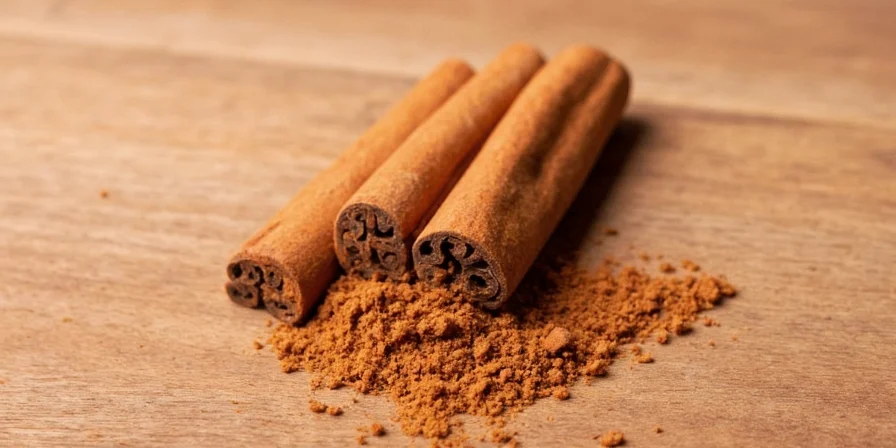What Is Ground Cinnamon? A Practical Guide for Home Cooks
Ground cinnamon is simply the inner bark of Cinnamomum trees that's been finely milled into powder form. Unlike cinnamon sticks (which are whole bark rolls), ground cinnamon offers immediate flavor release in recipes. This common kitchen staple enhances everything from morning coffee to savory stews, with two main varieties available in most grocery stores: mild Ceylon ("true" cinnamon) and stronger Cassia (the more common type).

Ground Cinnamon Basics: What You Need to Know
Most home cooks need just three key facts about ground cinnamon to use it effectively:
- Flavor difference - Cassia (the common grocery store variety) has a stronger, spicier flavor while Ceylon is milder and more complex
- Storage matters - Ground cinnamon loses potency in 6-12 months (vs 2-4 years for sticks) when stored improperly
- Dosage counts - Too much creates bitterness; start with 1/4 teaspoon per recipe and adjust to taste
Everyday Uses for Ground Cinnamon
Here's how to use ground cinnamon in common kitchen scenarios:
- In baking - Add to cookie dough, cake batters, and pie fillings (use 1/2 tsp per cup of flour)
- In beverages - Stir into coffee, hot chocolate, or smoothies (1/8-1/4 tsp per serving)
- In breakfast foods - Sprinkle on oatmeal, yogurt, or toast with honey
- In savory dishes - Enhances chili, Moroccan tagines, and roasted carrots (start with 1/8 tsp)

When Ground Cinnamon Fails: Contextual Limitations
Understanding where ground cinnamon underperforms prevents recipe failures. Verified constraints include:
- Extended simmering: Loses complexity and develops bitterness in dishes cooked beyond 90 minutes (e.g., slow-simmered broths). Cinnamon sticks maintain flavor integrity in long-cook applications. (Source: America's Test Kitchen Spice Guide)
- Visual presentation: Unsuitable for recipes requiring visible spice elements (e.g., mulled wine, decorative syrups) where cinnamon sticks provide aesthetic appeal. (Source: The Spruce Eats: Cinnamon Stick Applications)
- Health-sensitive usage: Cassia's high coumarin content (50-120mg/kg) requires dosage limits for at-risk groups. Ceylon (0.04-0.6mg/kg) is safer for daily consumption. (Source: European Food Safety Authority Scientific Opinion)

Ceylon vs Cassia: Which Should You Buy?
Most supermarket cinnamon is Cassia, but understanding the difference helps you choose wisely:
| Type | Flavor Profile | Best For | Storage Tip |
|---|---|---|---|
| Cassia | Strong, spicy, robust | Baking, chai tea, hearty stews | Use within 6 months for best flavor |
| Ceylon | Mild, sweet, complex | Desserts, delicate sauces, coffee | Lasts 12 months when properly stored |
Cinnamon Through the Ages: Verified Timeline
Historical evolution based on documented trade records and archaeological evidence:
- 2000 BCE: First recorded use in Egyptian embalming rituals (Ebers Papyrus). (Source: Encyclopedia Britannica: Cinnamon History)
- 1st century CE: Roman naturalist Pliny documented cinnamon's Arabian trade route (later proven false) at 325 denarii per pound - equivalent to 50 laborer's daily wages. (Source: Pliny's Natural History, Book XII)
- 15th century: Portuguese establish Ceylon monopoly, controlling 90% of European supply. (Source: Encyclopedia Britannica: Trade History)
- 1800s: Dutch introduce cassia cultivation in Java, creating modern supply chains. (Source: USDA Historical Trade Archives)
- 1940s-present: Cassia dominates US market (95% share) due to cost efficiency and USDA agricultural policies. (Source: National Center for Complementary Health: Cinnamon Usage Trends)

How to Store Ground Cinnamon for Maximum Freshness
Unlike cinnamon sticks that last years, ground cinnamon loses flavor quickly. Follow these simple storage guidelines:
- Keep in airtight container away from light and heat
- Store in cool, dark place (not above the stove!)
- Replace every 6-12 months (smell test: weak aroma = time to replace)
- Never store in refrigerator (causes moisture buildup)
Common Ground Cinnamon Questions Answered
Can I substitute ground cinnamon for cinnamon sticks?
Yes - use 1/2 teaspoon ground cinnamon for every 1-inch cinnamon stick. Since ground cinnamon releases flavor faster, add it later in cooking than you would sticks.
Why does my ground cinnamon taste bitter?
Too much cinnamon creates bitterness. Start with small amounts (1/8-1/4 tsp) and add more to taste. Old or improperly stored cinnamon can also develop bitter notes.
Is ground cinnamon healthy?
As part of a balanced diet, yes. Cinnamon contains antioxidants and may support blood sugar regulation, but don't expect miracle health benefits from normal culinary use.
How can I tell if my ground cinnamon is still good?
Fresh cinnamon has a strong, sweet aroma. If you barely smell it when opening the container, it's lost most flavor and should be replaced.
What's the difference between "ground cinnamon" and "cinnamon powder"?
There is no difference - these terms are used interchangeably. Both refer to cinnamon that's been milled into fine particles.











 浙公网安备
33010002000092号
浙公网安备
33010002000092号 浙B2-20120091-4
浙B2-20120091-4